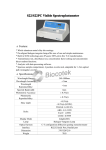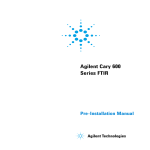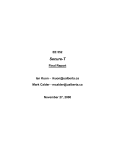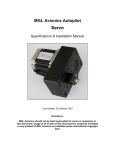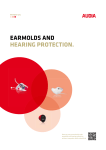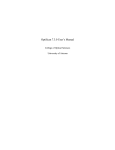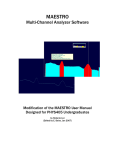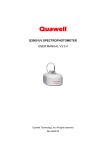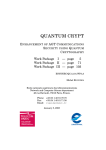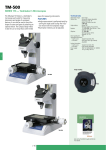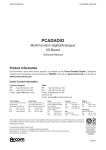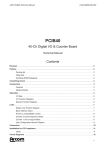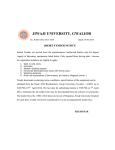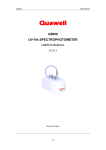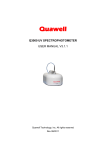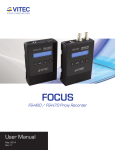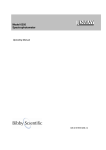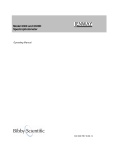Download Lambda Sci Catalog V1.pub - Lambda Scientific Pty Ltd
Transcript
C A T A L O G U E V-1 [email protected] www.lambdasci.com Lambda Scientific Pty Ltd COMPANY PROFILE Lambda Scientific specializes in developing and manufacturing various spectrophotometers, spectroscopic instruments, thin film measurement, microplate reader, physics education equipment, opto-mechanical parts, and laboratory light sources. Spectrophotometer products include FTIR, ultraviolet-visible spectrophotometers. Our spectroscopic instruments include laser Raman spectrometer, multifunctional grating spectrographs and monochromators. They are either manual or computer-controlled. Physics experimental instruments and education kits cover a wide range of experimental projects in general physics, especially in geometrical, physical, modern and fiber optics. We also provide a variety of opto-mechanical parts and optical breadboards. Laboratory light sources include xenon lamps, mercury lamps, sodium lamps, bromine tungsten lamps and various lasers. Our products have been sold around the world. Lambda Scientific is committed to providing high quality, cost effective products and on-time delivery. Lambda Scientific Pty Ltd CONTENTS Spectrophotometers LIVI-300 Visible Spectrophotometer............................................................................................1 LIUV-201 UV/Vis Spectrophotometer..........................................................................................1 LIUV-210 UV/Vis Spectrophotometer..........................................................................................2 LIUV-310 UV/Vis Spectrophotometer..........................................................................................2 FTIR-7600 FT-IR Spectrometer...................................................................................................3 Microplate Instruments LIMR-200 Microplate Reader.......................................................................................................4 LIWA-100 Microplate Washer......................................................................................................5 Spectroscopic Instruments LIRA-300 Laser Raman Spectrometer.........................................................................................6 LEOI-94 Monochromator..............................................................................................................6 LEOI-100 Experimental CCD Spectrometer.................................................................................7 LEOI-101 Multifunctional Grating Spectrometer...........................................................................8 Thin Film Measurement LIMF-10 Optical Thin Film Measurement.....................................................................................9 Experimental Instruments LEOI-20 Michelson Interferometer.............................................................................................10 LEOI-21 Michelson and F-P Interferometer...............................................................................10 LEOI-22 Precision Interferometer...............................................................................................11 LEOI-26 ESPI Experimental System..........................................................................................12 LEOI-30 Diffraction Intensity System.........................................................................................13 LEOI-40 Experimental System for Polarized Light.....................................................................13 LEOI-50 DPSS Laser Demonstrator..........................................................................................14 LEOI-51 He-Ne Laser Mode Analyser.......................................................................................15 LEOI-61 Single-photon Counting Experiment System..................... .........................................15 LEOI-200 Fourier Transform Visible Spectrometer.... ...............................................................16 LEDI-1 Experimental Unit of Planck’s Constant.........................................................................16 LEMI-1 CCD Young’s Modulus Measuring Instrument...............................................................17 LETI-1 Thermal Expansion Experiment Unit..............................................................................18 Lambda Scientific Pty Ltd Education Kits LEOK-1 Optics Experiment Kit................................................................................................. .19 LEOK-2 Holography and Interferometry Kit................................................................................19 LEOK-3 Optics Experiment Kit...................................................................................................19 LEOK-4 Geometrical Optics Experiment Kit...............................................................................20 LEOK-5 Lens Aberration and Fourier Optics Kit.........................................................................21 LEOK-10 Room Light Holography Kit.........................................................................................21 LEOK-20 Fibre Optics and Communication Experiment Kit.......................................................22 LEOK-21 Fibre Optics and Communication Experiment Kit.......................................................22 LEOK-22 Fibre Optics and Communication Experiment Kit.......................................................22 LEOK-30 Newton’s Ring Apparatus...........................................................................................23 Light Sources LLC-1 Tungsten-Bromine Lamp.................................................................................................24 LLC-2 Deuterium and Tungsten-Bromine Lamp........................................................................24 LLC-3 Adjustable White Light Source........................................................................................24 LLC-4 White Light Source..........................................................................................................24 LLC-5 Dual Purpose Tungsten Lamp.........................................................................................24 LLC-6 Small Illuminating Lamp..................................................................................................24 LLC-7 High Pressure Spherical Xenon Lamp............................................................................24 LLC-8 IR Light Source...............................................................................................................24 LLE-1 Low Pressure Mercury Lamp..........................................................................................25 LLE-2 Sodium Light Lamp.........................................................................................................25 LLE-3 Multiple Discharge Lamp............................................................................................. ..25 LLE-4 Hydrogen Lamp..............................................................................................................25 LLE-5 Hydrogen Lamp..............................................................................................................25 LLE-6 High Pressure Spherical Mercury Lamp.........................................................................25 LLE-8 Hydrogen-Deuterium Lamp.............................................................................................25 LLE-9 High Pressure Mercury Lamp..........................................................................................25 LLL-1 Semi-conducting Laser....................................................................................................26 LLL-2 He-Ne Laser....................................................................................................................26 LLL-3 Green Laser.....................................................................................................................26 LLL-4 Open Cavity He-Ne Laser................................................................................................26 Spectrophotometers LIVI-300 Visible Spectrophotometer LIVI-300 Visible Spectrophotometer is a single beam, general purpose instrument designed to meet the needs of the laboratories for analysis. It is ideal for various application fields such as chemistry, medicine, environmental protection, food and beverage, wine industry and quality control. Specifications Optical System Single beam, grating,1200l/mm Wavelength Range 325-1000 nm Wavelength Accuracy ±2 nm Wavelength Repeatability 1 nm Photometric Range 0-125%T, 0-2.0A, 0-1999C(0-1999F) Photometric Accuracy ±1.0%T Photometric Repeatability ≤ 0.5%T Stray Light ≤ 0.5%T at 340 nm and 400 nm Bandwidth 5nm Modes Data Output RS-232 Power 220~240VAC/50Hz or 110VAC/60Hz Standard Holder Installed Test Tube Holder (8 to 25 mm dia.) • • • • Dimensions 408 x 308 x 180 mm Weight 6.5 kg Features • • • • • Digital display of photometric result Dynamic range of 325-1000nm Flexible sample compartment Auto zero function Easy operation Transmittance Absorbance Concentration Factor LIUV-201 UV-Vis Spectrophotometer LIUV-201 is a stand-alone model with 2nm fixed bandwidth. It provides excellent performance for measurements in the range of 190nm to 1100nm. It has a large angled LCD screen with contrast adjustment for comfort viewing. The large sample compartment accommodates a wide range of cell holders and accessories including sipper and a peltier system. Optional Windows post-run application software make this instrument very versatile. Features • Automatic wavelength scanning • Full A4 print-outs of graphs and tables of results • Accommodates a wide range of cell holders • Real-time clock for date and time stamping • Non–volatile memory and one-button recall • Performance validation and report • Pre-aligned lamps for easy replacement • Full CE and C-tick compliance [email protected] 1 Spectrophotometers Specifications Modes Monochromator Single beam, grating system 1200 lines/mm Wavelength Range 190-1100nm Wavelength Accuracy ±0.5nm Wavelength Repeatability 0.3nm Wavelength Resolution 0.1nm Photometric Range 0-200%T, -0.3-3.0A, 0-9999Conc. Photometric Accuracy ±0.5%T Photometric Repeatability ±0.3%T Stray Light ≤0.05%T@220nm&340nm Bandwidth 2nm Stability < 0.002A/h@500nm Baseline Straight ±0.004A Scanning Speed Hi, Med., Low, Max. 1000nm/min Display Graphic LCD(320×240) dots Keyboard 29 Membrane keyboard Data Output RS-232 Light Source Tungsten Halogen/Deuterium Lamp Detector Solid Silicon Photodiode Scanning Speed Hi, Med., Low. Max. 1000 nm/min 1. Basic Mode 2. Quantitative 3. WL scan 4. Kinetics 5. DNA/Protein 6. Multi Wavelength 7. Utility - GLP 8. Defined Test LIUV-210/310 UV-Vis Spectrophotometer LIUV-210/310 is a single-beam/dual-beam UV/Vis spectrophotometer with 1.8nm fixed or variable bandwidth. This instrument can be operated by a PC via a USB cable. It can also be operated through the front panel display for basic functions. Fast scan speeds, accuracy and high resolution are its features. It is an indispensable analysis tool for various application fields such as chemistry, medicine, food and beverage, wine industry, chemical engineering and quality control. Features • Single/dual beam and automatic wavelength scanning • Measurement of specified wavelength T, A, C • Scanning interval: 0.1, 0.5, 1, 2, 5 nm • Dynamic feedback ratio recording photometric system, with baseline stability • Quick scanning up to 800 nm/min, 3 scan speeds • Recording baseline of full wavelength range • LCD screen, soft touch buttons, easy operation. • USB interfaced and easy software upgrading • Powerful software with quantitative analysis. Modes 1. Quantitative 2. Kinetics 3. Standard Curve 2 4. Sample scan 5. Multi Wavelength test 6. DNA/Protein www.lambdasci.com Spectrophotometers Specifications LIUV-210 LIUV-210S LIUV-310 Single-beam, grating system 1200 lines/mm Monochromator Wavelength Range LIUV-310S Dual-beam, single monochromator grating system 1200 lines/mm 190-1100nm Wavelength Accuracy ±0.3nm Wavelength Repeatability 0.2nm Wavelength Resolution 0.1nm Photometric Range 0-125%T, -0.3-3.0A, 0-9999Conc. Photometric Accuracy ±0.3%T Photometric Repeatability ±0.3%T Stray Light ≤0.15%T@220nm&340nm Bandwidth 1.8nm 0.5, 1, 2, 4nm Stability 1.8nm 0.5, 1, 2, 4nm < 0.002A/h@500nm Baseline Straight ±0.004A Scanning Speed Hi, Med., Low, Max. 800nm/min Data Output USB standard interface Light Source Tungsten Halogen/Deuterium Lamp FTIR-7600 FT-IR Spectrometer FTIR-7600 is a single-beam FT-IR spectrometer. This instrument is operated by a PC with user friendly software and a comprehensive manual. Fast scan speeds, high accuracy and ease with operation are standard features. It is an indispensable analysis tool for various application fields such as chemistry, biology, pharmaceutical, materials, mineral, food and beverage, wine industry and quality control. Specifications Wavenumber Range 7800~375 cm-1 Resolution 1 cm-1 Signal Noise Ratio 20000:1 (resolution@4cm-1; sample and background scan for 1 min@2100cm-1) Detector High performance DLATGS Beamsplitter Coated KBr Light Source Long life, steady state infrared emitter Electronic System A/D converter of 24 bits at 500MHz, USB 2.0 Power 110-220V AC, 50-60Hz Dimensions 450mm x 350mm x 210mm Weight 14 kg [email protected] 3 Microplate Instruments LIMR-200 Microplate Reader LIMR-200 Microplate Reader is mainly used on clinical immunity-tests in the hospitals or epidemic prevention stations. It has good characteristics such as high sensitivity, high accuracy, fast checking, and ease for operation etc. The instrument has a dedicated keyboard that enables you to rapidly change functions and set parameters. Display is a LCD with alphanumeric and graphic options. Setting and detecting operations are easy and straightforward. Features • Detect absorbance and carry out detection based on quality • Save inspection commonly used programs in advance and and quantity respectively display the program list on the LCD • Automatically select filters for different items • Has the ability to print results directly • Conduct auto-check first when it starts up, and an initial setting and self-checking will begin. Specifications Measurement Range 0.0A ~ 3.0A Absorbance Accuracy Error 0.1~1.0: >1.0~2.0: >2.0~3.0: Wavelength Range 400-700 nm Filters 405nm, 450nm, 492nm, 630nm up to 7 filters Accuracy of Filters ±3.0nm Half-width of Filters ≤12nm Repeatability ≤1.0% Stability ≤±0.005A/10min Linearity Reading Speed 4 ±1% or ±0.01Abs ±2% or ±0.02Abs ±10% or ±0.10Abs 0.1~1.0: ±1.25% >1.0~2.0: ±2% >2.0~3.0: ±8% <5secs/96holes (single wavelength) <7secs/96holes (double wavelength) Measurement System 8-channel optical system with self calibration Shaking 2 modes—user selectable Data Link RS-232 Display 240x128 pixels LCD screen Output Absorbance, qualitative judgment, value of P/CO, concentration, judgment of normal value and quality control value Programs 30 programs can be stored Dimensions and Weight 420 x 290 x 180 mm & 10 kg www.lambdasci.com Microplate Instruments LIWA-100 Microplate Washer LIWA-100 Microplate Washer is an accessory for the LIMR-200 Microplate Reader. The function of the instrument is to wash enzymatic plates after detection with its main usage in medical departments or clinics. It also can wash or add reagent in other fields such as refined chemistry, medicine and biochemistry. The instrument has a LCD, You can easily complete all your work by following the instrument’s prompts. It is a highly automated instrument. It enables you to individually program and save preset programs in the memory. Features • • • • • Automatic scouring of the instruments pipeline Various methods of cleaning to meet the requirement of different experiments Automatically flush the tube to avoid blockage resulted from lotion crystallization Simple interface for convenient operation Purpose: widely used in hospitals, blood stations, quarantine stations, reagent factories and laboratories. Specifications Washing Head 8 or 12 channels Applicable Microplate 96 or 48 wells microplates Washing Times Option 1~9 Washing Rows Option 1~12 Soak Time 1~3600s Residual Volume <3µl/well Programs up to 16 programs Injection Error <5% Steeping 1 to 600 seconds Dimensions 480mm×360mm×140mm Weight 11Kg Schematic [email protected] 5 Spectroscopic Instruments LIRA-300 Laser Raman Spectrometer LIRA-300 Laser Raman Spectrometer is a useful instrument for the identification of a wide range of substances in physics and chemistry laboratories of scientific research institutes, universities and colleges. It is a straightforward, nondestructive technique requiring no sample preparation, and it involves illuminating a sample with monochromatic light and using a spectrometer to examine the light scattered by a sample. Features • • • Computer-controlled, user friendly interface, capable of automatic record of Raman spectra. • • Diode-pumped solid state laser used as light source. • Various accessories available for analysis of liquid and solid samples . • Trap filter available for cutting stray light. Monochromatic system with high resolution and low stray light. Single-photon counter used as a receiver system, with high sensitivity and low noise. External optic path system provided, with good stability and high accuracy. Specifications Monochromator Optical Grating 1200 lines/mm, blazed wavelength at 500 nm Slit Width 0~2 mm, continuously adjustable Notch Filter (optional) 532 nm Single-photon Counter Integration Time 0~30 min Max Count 10 7 Wavelength Range 200~800 nm Wavelength Accuracy ≤0.4 nm Wavelength Repeatability ≤0.2 nm Stray Light ≤10 -3 Half-width of Spectral Line ≤0.2 nm at 586 nm LEOI-94 Monochromator LEOI-94 is manually operated monochromator that utilizes a dial for wavelength selection. Both the entrance and exit slits are straight with width continuously adjustable from 0 to 2mm with a reading resolution of 0.01mm. The beam passes through entrance slit S1 (S1 is on the focal plane of reflectance collimation mirror), then reflected by mirror M2. The parallel light shoots to grating G. Mirror M3 form the image of diffraction light comes from the grating on S2. 6 www.lambdasci.com Spectroscopic Instruments Specifications Wavelength Range 200-800 nm Grating 1200 lines/mm Relative Aperture D/F = 1/7 Wavelength Repeatability ≤ 0.2 nm Wavelength Accuracy ±0.4 nm Slit width 0 ~ 2 mm adj., Resolution: 0.01mm Focal Length 300 mm Dimensions 370 x 250 x 210 mm LEOI-100 Experimental CCD Spectrometer LEOI-100 Experimental CCD Spectrometer is a general purpose and USB interfaced spectrum measuring instrument. It uses a linear CCD as a receiving unit capable of real-time acquisition and 3-dimensional display. It is ideal equipment for studying the spectra of various light sources or calibrating optical probes. Experiment Examples • • • CCD spectrometer calibration Observation of light source spectra, such as Sodium or Mercury lamp Measurement of Rydberg Constant Specifications Experimental CCD Spectrometer Wavelength Range 300 ~ 900 nm Focal Length 302.5 mm Relative Aperture D/F=1/7 Resolution ≤ 0.2 nm Wavelength Accuracy ≤ 0.4 nm Wavelength Repeatability ≤ 0.2 nm Stray Light ≤ 10-3 Slit Width 0 to 2 mm, adjust., 0.01 mm Grating 600l/mm, blazed at 550 nm CCD Receiver 2048 cells Integration time: 1 ~ 88 stops Yellow and White Filters Yellow filter: 320 ~ 500 nm, White filter 500 ~ 900 nm [email protected] 7 Spectroscopic Instruments LEOI-101 Multifunctional Grating Spectrometer The LEOI-101’s modular structure makes experiments and tests much easier and are recommended to physics laboratories of institutions of higher learning. The system will measure Hydrogen-Deuterium and Sodium spectrum more accurately than conventional spectrometers. Extensive experiments and test measurements have proved that the spectrometer has a high performance in a wide range of applications. It provides flexible solutions for optical measurements. Emission and absorption spectra can be measured. It is USB interfaced with friendly Windows application software Experiment Examples • • • CCD spectrometer calibration Observation of light source spectra, such as Sodium or Mercury lamp Measurement of Rydberg Constant Specifications Grating Monochromator Focal Length 500 mm Wavelength Range 200~660 nm Relative Aperture D/F=1/7 Grating 2400 lines/mm; blazed wavelength at 250 nm Stray Light ≤10-3 Resolution ≤0.06 nm Photomultiplier Tube Wavelength Range 200~660 nm Wavelength Accuracy ± 0.2 nm Repeatability of Wavelength ≤ 0.1 nm CCD Receive Unit 2048 cells Spectral Response Range 300~660 nm Integrating Time 88 stops Filter Weight 8 White filter: 320~500 nm; yellow filter: 500~660 nm 25 kg www.lambdasci.com Thin Film Measurement LIMF-10 Optical Thin-Film Measurement Thin films are widely used in a variety of applications and the Thin-Film Measurement System can easily determine their properties. Based on interference spectral analysis of multi-reflection beams, this instrument functions noncontact optical measurement of thickness, refractive index and extinction coefficient of various thin films and coatings. With dedicated hardware design and program development, this measurement system is easy to setup and the software is user friendly. It is suitable for both on-line manufacturing and desktop measuring. Measurement Features • • • • • • Substrate refractive index and absorption index Flexible choice of computation wavelength range (within the PC based spectrometer) Film thickness, mean and standard deviation Film material refractive index and absorption index evaluation Data loading of previously saved reflectance data • film and substrate materials • Statistics of measurement results Convenient selection from an included database with various User defined materials selectable and user defined material data import/export Specifications Measurement Range Thickness only 20nm to 50µm Thickness with n and k 100nm to 10µm Wavelength Range Spectrometer 350nm to 1000nm Light source 360nm to 2500nm Accuracy The greater of ± 1 nm or ± 0.5% Precision 0.2nm Repeatability 0.1nm Spot size Adjustable 0.8mm to 1cm (10µm with a microscope) Sample size From 1mm and up Layers Up to 4 layers Detector type 2048-element linear silicon CCD array Light source Tungsten Halogen [email protected] 9 Experimental Instruments LEOI-20 Michelson Interferometer The Michelson interferometer produces interference fringes by splitting a beam of monochromatic light so that one beam strikes a fixed mirror and the other a movable mirror. When the reflected beams are brought back together, an interference pattern results. It can be used for observing interference fringes and precisely measure wavelengths, distance and index of refraction. Experiment Examples • • • • • • Interference fringes of a He-Ne laser Equal inclination interference and equal thickness interference Wavelength measurement White light fringes (with optional item 6) Measurement of wavelength separation of Sodium doublet (with optional item 6) Measurement of the refractive index of air versus pressure (with optional item 7) Specifications Interferometer main frame Flatness of Beam Splitter and Compensator 0.05λ Travel of Movable Mirror 1.25mm (travel of micrometer: 25mm) Minimum Travel Reading 0.0005mm Wavelength Measurement Accuracy Relative error of 2% for 100 fringes Overall Dimensions 350×350×285mm Weight of Main Frame Approx. 17kg He-Ne laser [email protected] Frosted glass screen d = 60mm Sodium-Tungsten lamp (Optional) Sodium: 10W, Tungsten: 15W Air Chamber with Gauge (Optional) Chamber length of 80mm, gauge: 0 ~ 40Kpa LEOI-21 Michelson and F-P Interferometer This equipment combines the important Michelson interferometer and the high resolution Fabry-Perot interferometer in one rigid and compact structure. Measurements are precise in two modes of operation. Switching between the two modes of operation and aligning components is relatively simple. This instrument is suitable for physics teaching in universities and colleges. 10 www.lambdasci.com Experimental Instruments Experiment Examples Michelson Interferometer • • • • Interference fringes Equal inclination interference Equal thickness interference • Refractive index of air versus pressure Fabry-Perot Interferometer • • Multiple beam Interference Sodium D-lines separation and measurement White light fringes Specifications Interferometer main frame Flatness of Beam Splitter and Compensator 0.05λ Travel of Movable Mirror 1.25mm (travel of micrometer: 25mm) 10mm for presetting (coarse micrometer) Minimum Travel Reading 0.0005mm Wavelength Measurement Accuracy Relative error of 2% for 100 fringes Overall Dimensions 350×350×245mm Weight of Main Frame Approx. 17kg He-Ne laser [email protected] Laser holder Frosted glass screen d = 60mm Sodium-Tungsten lamp Sodium: 10W, Tungsten: 15W Air Chamber with Gauge Chamber length of 80mm, gauge: 0 ~ 40Kpa Small Telescope (optional) 6×, with holder LEOI-22 Precision Interferometer This equipment combines the Michelson interferometer, the high resolution Fabry -Perot interferometer and the useful Twyman-Green interferometer. Measurements are precise in three classical modes of operation. Switching between the three modes of operation and aligning components are very simple, as this complete set of high quality components is carefully mounted on a heavy, stable base. Experiment Examples Michelson Interferometer • • • • • • • Interference fringes observation Equal thickness interference Determination of wavelength • Refractive index of air Fabry-Perot Interferometer • • Refractive index of transparency slice Equal inclination interference White light interference Precise comparing of wavelengths Multiple beam Interference Measurement of the Wavelength Separation of Sodium D-lines • Measurement of λ of He-Ne Laser Twyman-Green interferometer • Demonstration of Twyman-Green interferometer [email protected] 11 Experimental Instruments Specifications Interferometer main frame Flatness of Beam Splitter & Compensator Better than 1/10 λ Min Division Value of Micrometer 0.01mm, corresponds to a movement of 0.00025mm of movable mirror Travel of Micrometer 25mm for fine micrometer 10mm for presetting (coarse micrometer) Travel of Movable Mirror 0.625mm Fabry-Perot Mirror 30 mm, 95% T Wavelength Measurement Accuracy Relative error of 2% for 100 fringes He-Ne laser [email protected] Laser holder Frosted glass screen d = 60mm Sodium-Tungsten lamp Sodium: 10W, Tungsten: 15W Air Chamber with Gauge Chamber length = 80mm, gauge: 0 ~ 40Kpa Transparency Slice Clip 2 Samples LEOI-26 ESPI Experimental System Electric speckle interference experimental system (ESPI) makes use of speckle, which is the carrier of rough surface information, to study a substance. It is a modern optical measuring technique that covers the fields of image processing techniques, laser technology and holographic interference techniques. Due to the coherence of the laser, the speckle is so obvious that can be easily and clearly shot by a CCD camera and the data as well as an image attained can be processed by a computer. Experiment Examples • • Measurement of a heated aluminium block Measurement of a deformed metal plate Specifications 12 He-Ne Laser with Power Supply 1.5 [email protected] Measurement Error 1/2 λ @ 632.8nm Beam Expander f = 4.5mm Beam Splitter 6:4, 60x50x6.3 mm Lens f = 70mm B/W CCD with Power Supply 752 (H) x 582 (V) pixels Image Card 640 x 480 x 16 bit www.lambdasci.com Experimental Instruments LEOI-30 Diffraction Intensity System The Diffraction Intensity System enables you to quantitatively investigate diffraction effects. To capture and analyze the diffraction patterns, we use a photocell to transform the diffraction pattern into a current and then read from a LED display. As it is designed for students to improve and consolidate their understanding on intensity distribution of diffraction, this system allows students to draw curves of the diffraction pattern with numerical data recorded. Experiment Examples Near-field diffraction—Fresnel Far-field Diffraction—Fraunhofer • • • • • • • At a single slit At a circular aperture At a straight edge At a single slit At a double slit At a multi-slit At a single circular aperture Specifications Optical rail and base 1 m long, black anodized aluminum with power supply He-Ne Laser [email protected] Multi-hole plate 8 holes, 0.1, 0.15, 0.2, 0.3, 0.5, 0.7, 1, 2 mm in dia Displacement Range of Photocell 90mm Displacement resolution 0.01mm Receiving Unit 20µW ~ 200mW, 6 stops, with detector head Width of Adjustable slit 0 ~ 2mm Lens f = 6.2, 150mm Multi-slit plate 2, 3, 4, 5 slits Transmission grating 20l/mm (with mount) LEOI-40 Experimental System for Polarized Light LEOI-40 system has been developed to help students grasp the concept and mechanism of polarization. It allows the student to measure different types of polarization and the working parameters of the optical elements involved. The system is also designed to be operated manually and can improve students’ hands-on ability and consolidate the knowledge and skills they have learned. Experiment results collected can be graphed to schematically illustrate the theory of polarization. Experiment Examples • Polarized reflection • Measurement of Brewster angle • Verification of Malus' law [email protected] 13 Experimental Instruments Specifications Optical rail and base 1m long, black anodized aluminum with power supply He-Ne laser With Brewster window Wavelength and power [email protected] Polarization Ration Linear Power Stability 5% Tube Working Voltage 1200V Divergence <1.3mrad Single-sided slit Slit width: 0 to 5mm, slit tilt-able: ±5° Polaroid Φ20mm with holder 1/2 Wave plate Φ10, λ=632.8nm, quartz 1/4 Wave plate Φ10, λ=632.8nm, quartz Lens f = 150mm Black glass 50×27 mm Beam splitter f = 4.5mm Small light source High brightness LED Photocurrent amplifier Gain adjustable LEOI-50 DPSS Laser Demonstrator LEOI-50 is designed for nonlinear optical experiments for laser education at universities/colleges. It can help students to understand the theory of diode pumped solid state lasers (DPSS) and frequency doubling. A solid state laser pumped by a semiconductor laser at 808nm, emits infrared light at 1.064µm. By putting a KTP crystal into the cavity you can generate frequency-doubled green light. During the experiment, a lot of light path adjustment is involved, allowing students to be more practically familiar with the principle. Specifications 14 Optical Rail with Base 1.1m long, black anodized aluminum with power supply Semiconductor Laser 808nm, ≤ 500mW Laser Driver Current Control Output: 0 ~ 500mA He-Ne Laser 1.5 [email protected] nm KTP Crystal 2 × 2 × 5mm Nd:YVO4 Crystal 3 × 3 × 1mm Output Mirror Dia: 6mm, R = 50mm Optical Filter 10 mm aperture Laser Power Indicator 2µW ~ 200mW, 6 stops IR Viewing Card 750 ~1600 nm Maximum Green Laser Output <40mW@532nm Key Features www.lambdasci.com • • • 532 nm laser output power between 10 ~ 40mW Variable pumping current Understand the theory through practice Experimental Instruments LEOI-51 He-Ne Laser Mode Analyzer LEOI-51 He-Ne Laser Mode Analyzer allows users to quantitatively assess the mode characteristics of a He-Ne laser. Users may perform laser mode analysis on a computer and may also observe mode spectrum with an oscilloscope. Theoretical and practical descriptions supplied with the device will assist you. Experimental Examples • • • • Familiar with principle and operation of con-focal spherical scanning interferometer Observation of longitudinal and transverse modes distribution. Observation of several of modes of different lasers Determination of mode structure by calculating modes spacing of the laser Specifications Optical Rail and Base He-Ne Laser Power Supply and Sawtooth Signal Generator are built inside the base He-Ne Laser [email protected] nm Cavity Length 246 mm Center Wavelength 632.8 nm Confocal Scanning Interferometer Cavity Length 20 mm Curvature of Concave Mirror 20 mm Reflectivity of Concave Mirror 99% Finesse >200 Free Spectral Range (FSR) 4 GHz Mode Spacing Error < 20 MHz High Speed Receiver LEOI-61 Single-Photon Counting Experiment System Based on a reliable PMT sensitivity in the visible spectral range, this photon counting system is able to detect weak optical signals down to the single photon level. It is important in many quantum information processing applications. Photon counter functions by absorbing photons from the field, converting single photons into electronic information (many thousands of electrons) with high quantum efficiency. Experimental Examples • • • • Determining the detection sensitivity Measuring the photon counting ratio Determining the receiving light power Measuring the relationship between the operating temperature and the darkcounting ratio [email protected] 15 Experimental Instruments Specifications Detector CR125 Photomultiplier tube Wavelength Range 360-650 nm Wavelength Repeatability ≤0.2nm Integration Time 0-30 min (1ms/stop, adjustable) Threshold Voltage 0-2.56V (10 mV/stop, adjustable) Max Count Reading more than 107 Dark Count less than 30cps (-20°C) Relative Aperture Continuously adjustable from 0 to 2mm Stray Light ≤10 Resolution ± 0.4nm Semiconductor refrigeration system ≥-20º C -3 LEOI-200 Fourier Transform Visible Spectrometer LEOI-200 Fourier Transform Spectrometer is designed to demonstrate the measurement of the spectrum of the light sources by means of Fourier Transform. It adopts an open structure of the optical path and measurement in visible spectrum (400 to 800 nm), which makes it ideal for demonstration of a Fourier Transform. Experiment Examples • Observation of light source spectra, such as Sodium or Mercury lamp • Retrieve Interferograms • Many functions attached with the software Specifications Wavelength Range 400 to 800nm Wavelength Resolution 1nm Wavelength Accuracy 1nm Beam Expander f = 4.5 mm Windows Software and User Manual LEDI-1 Experimental Unit of Planck’s Constant The measurement of Planck's constant has being carried out in many educational institutions with a variety of approaches. This experimental unit uses the photoelectric effect, where electrons stimulated by incoming light, create an electric current to experimentally determine the value of Planck's constant (h). This unit also encourages students to get a fundamental understanding of the quantum character of light and to gain experience with experimental skill related to photoelectric effect. 16 www.lambdasci.com Experimental Instruments Experiment Examples • Comparison of light’s wave model and quantum model • Measurement of Planck Constant Specifications Experimental Unit Fan 0.17A for abstraction of heat Condenser f’ = 50mm, f’ = 70mm Tungsten-Bromine lamp 12V, 75W Monochromator Grating type Wavelength range 200-800nm C12V Slit width 0-3mm Wavelength accuracy ±3nm Wavelength repeatability ±1nm Approximate I-V curve indicating the photoelectric cell’s volt-ampere characteristic Photoelectric tube GD31A type DC regulated power supply ±1.8V Measuring Amplifier 4 stop,100µA, magnetoelectric LEMI-1 CCD Young’s Modulus Measuring Instrument Young’s Modulus, E, is a constant that describes the material’s mechanical property of stiffness and is expressed as the ratio of stress to strain for a material experiencing tensile or compressive stress. We designed this apparatus to demonstrate that the deformation is proportional to the strain for a metal wire under load which is parallel to the axis of the wire and is applied to one end while the opposite end is held fixed. A microscope and CCD image-forming system is equipped. Experiment Example • Measurement of Young’s Modulus Specifications Experimental Unit Stainless Steel Wire 50 cm long, 0.20 mm in diameter Molybdenum Wire 50 cm long, 0.1 mm and 0.18 mm in diameter Upright Column About 60 cm in height Operating Temperature -5°~ 40° Ambient Humidity 10 ~ 80 % Relative Uncertainty of Measurement <5% Weights 100g, 200g Microscope Measuring range: 3 mm, minimum CCD camera Black and White, Effective pixel: 752(H) ×582(V), Camera lens: f =16mm Video Monitor Black and White, 14 inch, Impedance: 75 Ω [email protected] 17 Experimental Instruments LETI-1 Thermal Expansion Experiment Unit This unit utilizes a Michelson interferometer to determine the linear expansion coefficient of the sample materials very accurately. With an oven for the thermal expansion and a mirror attached to the sample acting as a movable mirror in a Michelson interferometer, this specially design unit makes use of the interference pattern to determine the linear expansion by counting fringes. Experiment Examples Measurement of Linear Thermal Expansion Coefficient by: • Preset Temperature • Preset Length Specifications Thermal Expansion Experiment Unit Heating Range 18~ 60°C, temperature controlled Temp. Measuring Accuracy 0.1 °C Power Consumption 50 W Error of Linear Expansion Coefficient < 3% He-Ne Laser 1 [email protected] Plane Mirror with quartz tube and connector Lift Tool with M4 screw Aluminum Alloy Sample L =150mm Copper Alloy Sample L =150mm Steel Sample L =150mm 18 www.lambdasci.com Education Kits LEOK-1 Optics Experiment Kit The LEOK-1 Optics Experiment Kit is developed for general physics education in universities and colleges. It can be used to construct eight experiments, covering the basic experiments in geometrical optics, physical optics and information optics. LEOK-1 can also be upgraded to include extra experiments by adding the corresponding parts from LEOK-3. Experiment Examples 1. Measuring Focal Length Using Autocollimation 2. Measuring Focal Length Using Displacement Method 3. Assembling a Slide Projector 4. Young’s Double-Slit Interference 5. Fresnel Diffraction of Single Slit 6. Fresnel Diffraction of Single Circular Aperture 7. Abbe Imaging Principle and Optical Spatial Filtering 8. Pseudo-color Encoding, Theta Modulation and Color Composition LEOK-2 Holography & Interferometry Kit The LEOK-2 Holography and Interferometer Kit is developed for general physics education in universities and colleges. It provides a complete set of optical and mechanical components as well as light sources. Through selecting and assembling corresponding components into complete setups, students experimental skills and problem solving ability can be greatly enhanced. Experiment Examples 1. Recording and reconstruction of holograms 2. Making holographic grating 3. Constructing a Michelson interferometer 4. Constructing Sagnac interferometer 5. Constructing Mach-Zender interferometer LEOK-3 Optics Experiment Kit The LEOK-3 Optics Experiment Kit is developed for general physics education in universities and colleges. It provides a complete set of optical and mechanical components as well as light sources. Almost all optics experiments required in general physics education (e.g. geometrical, physical, and modern optics) can be constructed in sequence using these components. Through selecting and assembling corresponding components into the complete setups, students experimental skills and problem solving ability can be greatly enhanced. [email protected] 19 Education Kits Experiment Examples 1. 2. 3. 4. 5. 6. 7. 8. 9. 10. 11. 12. 13. 14. 15. 16. 17. 18. 19. 20. 21. 22. 23. 24. 25. 26. Measuring the focal length of a positive thin lens using auto-collimation Measuring the focal length of a positive thin lens using displacement method Measuring the focal length of an eyepiece Assembling a microscope Assembling a telescope Assembling a slide projector Measuring the nodal locations and focal length of a lens-group Assembling an erect imaging telescope Young’s double-slit interference Interference of Fresnel’s biprism Interference of double mirrors Interference of Lloyd’s mirror Interference of Newton Ring Fraunhofer diffraction of a single silt Fraunhofer diffraction of a single circular aperture Fresnel diffraction of single silt Fresnel diffraction of single circular aperture Fresnel diffraction of a sharp edge Analysing polarization status of light beams Diffraction of a grating Assembling a Littrow-type grating spectrometer Recording and reconstructing holograms. Making holographic gratings. Abbe imaging principle and optical spatial filtering. Pseudo-colour encoding, theta modulation and colour composition. Assembling a Michelson interferometer and measuring air refractive index LEOK-4 Geometrical Optics Experiment Kit This kit provides complete set of optical and mechanical components as well as light sources, which can be conveniently assembled to construct experimental setup of geometrical optics. Through selecting and assembling the corresponding components into the setups by students themselves, their experimental skills and problem solving ability can be greatly enhanced. Experiment Examples 1. Measuring focal length of a positive thin lens by measuring object length and image length 2. Measuring the Focal Length of a Positive Thin Lens Using Auto-collimation 3. Measuring the Focal Length of a Positive Lens Using Displacement Method 4. Measuring the Focal Length of a Concave Lens 5. Measuring Focal Length of an Eyepiece 6. Measuring the Nodal Locations and Focal Lengths of a Lens-Group 7. Assembling a Microscope 8. Assembling a Telescope 9. Assembling a Slide Projector 20 www.lambdasci.com Education Kits LEOK-5 Lens Aberration and Fourier Optics Kit There six basic optical aberrations affecting the ideal performance in an optical system, which are chromatic aberration, spherical aberration, coma, distortion, curvature of field and astigmatism. Optical lens can perform the Fourier transform to light field on object plane. Students will be enhanced their knowledge of Fourier optics, spatial filtering and aberrations through the proposed experiments. Experiment Examples Lens Aberrations 5. Image distortion 6. Chromatic aberration 1. Spherical aberration Fourier Optics and spatial filtering 2. Field Curvature 1. Include low-pass filtering high-pass filtering and directional filtering 3. Astigmatism 4. Coma LEOK-10 Room Light Holography Kit LEOK-10 Holography Kit is designed for basic education of holography in institutions of higher learning. While ideal for demonstrating in a classroom and physics lab, this kit is also suitable for amateurs who are fascinated with the startling real 3D effect that holograms produce. This holography kit gives you all the essentials to make white light holograms with ease. Every user can record rainbow holograms under ordinary light. Experiment Examples 1. Recording Reflection Holograms 2. Recording Transmission Holograms 3. Reconstruction of Holograms Key Features This cost effective kit provides you with the equipment required to make white light holograms with easy operation. A detailed practical procedure manual is supplied with this kit, allowing holography now accessible to everyone and easy to use. Specifications Semiconductor Laser 35mW@650 nm, bandwidth: 0.2nm Photopolymer Plate Resolution: 4000 l/mm, sheet: 90X240mm Exposure Timer and Shutter 0.1-999.9 s, LED, manual & remote control Optical Table 600X600X60mm A semiconductor diode laser, 35mW at 650nm, can greatly reduce exposure time, which decreases the influence of vibration on holographic recording. The digital electronic timer with a shutter employs IC technology in the timing electronics which ensures highly stable, accurate and reliable results. [email protected] 21 Education Kits LEOK-20 Fiber Optics and Communication Experiment Kit We designed this kit to satisfy the increasing demand from the support of laboratory based experiments. This kit will provide you essential basic knowledge and skills. Upon acquiring the laboratory techniques, which can be used for characterization of important fiber parameters through practical hands on experience, students may better appreciate the fascinating characteristics of fiber optics. Experiments Examples (7) 1) Experiment of fundamental knowledge of optical fiber optics 2) Experiment of coupling method between optical fiber and light source 3) Multimode fiber Numerical Aperture (NA) measurement 4) Optical fiber transmission loss property and measurement 5) M-Z optical fiber interference experiment 6) Optical fiber thermal sensing principle 7) Optical fiber pressure sensing principle LEOK-21 Fiber Optics and Communication Experiment Kit This Fiber Optic Experimental kit is a sister kit to LEOK-20, which has been revised and rewritten to include some new experiment. If you are looking for something more advanced, to continuously extend your learning in fiber optics, this kit supplies more equipments and offer more experiment required to measure parameters of optical fiber beam splitter, attenuator and isolator. Experiment Examples (10) Experiments 1) - 7) of LEOK-20 Plus: 8) Optical fiber beam splitter parameter measurement 9) Adjustable optical attenuator and parameter measurement 10) Fiber optic isolator and parameter measurement LEOK-22 Fiber Optics and Communication Experiment Kit This kit will provide an overview of fiber optic technology and basic skills needed to work with fiber optics. It is made up of 15 laboratory experiments. The most commonly used optical elements and their parameter measurements are introduced in this kit, together with prime techniques, such as WDM and coupling. Student may master characteristics of isolator, attenuator, optical switch, transmitter, amplifier etc. 22 www.lambdasci.com Education Kits Features ● ● ● ● ● ● ● ● ● 15 basic experiments required for students with major in optoelectronics and optical communication Enables students to characterize major components of optical fiber communication systems Allows students to investigate the prime issues of attenuation and dispersion Determine what factors influence performance of optical fiber communications system Quick installation, includes necessary optical elements and optoelectronic instrumentation Time saving and no preparation for the tutor, extensive literature support provided Competitive price with innovative design Suitable for different student levels Straightforward to reconfigure for open ended projects Experiments Examples (15) Experiments 1) - 10) of LEOK-21 Plus: 11) Fiber optic optical switch experiment 12) Wavelength division multiplexing (WDM) principle 13) Optical transmitter's extinction ratio measurement 14) Erbium-doped optical fiber amplifier principle 15) Open circuit audio analog signal transmission experiment LEOK-30 Newton’s Ring Apparatus The phenomenon of Newton's rings, named after Isaac Newton, is an interference pattern caused by the reflection of light between two surfaces - a spherical surface and an adjacent flat surface. When viewed with monochromatic light it appears as a series of concentric, alternating light and dark rings centered at the point of contact between the two surfaces. Using this apparatus, observation of equal thickness interference and calculation of surface curvature by measuring interference fringe separations of Newton Ring can be performed. Experiment Examples • • Observation of equal thickness interference Calculation of surface curvature Specifications Sodium Lamp with Power Supply 15 ± 5 V AC, 20W Reading Microscope Min Division of drum 0.01mm Magnification 20x, (1x, f = 38mm for Objectives, 20x, f =16.6mm for eyepiece) Working distance 76 mm View field 10 mm Measurement Range of reticule 8 mm Measurement Accuracy 0.01mm Radius of Curvature of Newton’s Ring 868.5mm Beam Splitter 5:5 [email protected] 23 Light Sources LLC-1 Tungsten-Bromine Lamp The LLC-1 is a compact instrument which produces strong light energy, making it an ideal visible and near IR light source. It can be used to analyse absorption and fluorescence spectra of a sample. Lamp power: 30W/12V LLC-2 Deuterium and Tungsten-Bromine Lamp The LLC-2 uses a special power supply to ensure steady and consistent lamp output and has excellent focusing power. It is an ideal ultraviolet-visible light source and can be used to analyse absorption and fluorescence spectra of a sample. LLC-3 Adjustable White Light Source Compact and robust. It can be used in the laboratory as an adjustable incandescence light source In addition, diffused reflected light can be generated through a frosted glass. Lamp power: 30W/12V LLC-4 White Light Source The LLC-4 can be used as an incandescence light source in the laboratory. Lamp power: 15W/6V LLC-5 Dual Purpose Tungsten Lamp The light of LLC-5 Tungsten-Bromine lamp passes through the optical system, and forms an approximate parallel beam. Various apertures and slits can be placed in the lamp housing. A planar light source is generated through spherical ground glass at the side of the lamp box and the output power can be adjusted continuously. Lamp power: 30W/12V LLC-6 Small Illuminating Lamp The LLC-6 is a very useful small illuminating lamp for laboratory use. Lamp power: 3VDC LLC-7 High Pressure Spherical Xenon Lamp (150W) LLC-7-75 (75W) The LLC-7 is a gas discharge light source. The lamp, filled with high pressure xenon gas, can be excited by high frequency and high voltage and will produce strong and continuous spectra from ultraviolet into the visible range. It is air-cooled by a fan. LLC-8 IR Light Source (porcelain clay rod) The LLC-8 light source is specifically designed to be used in the in 4000-400cm-1 range. It is powered by a special power supply, and equipped with light focusing and modulation capabilities. It can be used grating spectrometer for measuring infrared absorption spectrum. 24 www.lambdasci.com Light Sources LLE-1 Low-pressure Mercury Lamp The LLE-1 can be used as a standard light source to verify and adjust the wavelength precision and resolution of many instruments. :Lamp power: 20W LLE-2 Sodium Light Lamp The LLE-2 Sodium double lines emitted can be used for wavelength calibration and resolution adjustment. . It can also be used to study the sodium spectrum. Lamp power: 20W LLE-3 Multi-group Discharge Lamp The LLE-3 is a multi-group discharge light source consists of He, Ne, H, and N and designed to be used in teaching and research laboratories. The lamps wavelengths can be used for calibration purposes. LLE-4 Hydrogen Lamp The LLE-4 lamp generates the spectral lines of Hydrogen, 410.18nm, 434.05nm, 486.13nm and 656.28nm. It can be used to calibrate wavelength. It is widely used in physics lab at university or colleges, and is an essential experimental and teaching light source. LLE-5 Hydrogen Lamp The LLE-5 lamp generates the spectral lines of Hydrogen, 410.18nm, 434.05nm, 486.13nm and 656.28nm. It can be used to calibrate wavelength. As compared to the LLE-4 this model is designed with a stand for adjusting the height. LLE-6 High Pressure Spherical Mercury Lamp The LLE-6 is a small volume and high brightness point light source, and it will produce a strong ultraviolet-visible spectrum. The main spectral lines are 313.2nm, 334.1nm, 365nm, 366,3nm, 404.7nm, 435.8 and 456.1nm Lamp power: 200W LLE-8 Hydrogen-Deuterium Lamp The LLE-8 is gas discharge light source and has many applications in the physics laboratories, such as calibration etc. The main spectral lines are: Hydrogen: 410.18nm, 434.05nm, 486.13nm and 656.28nm Deuterium: 410.07nm, 433.93nm, 486.01nm, 656.11nm LLE-9 High Pressure Mercury Lamp The LLE-9 is a powerful arc-discharge mercury lamp. The high in-tube gas pressure and luminescent efficiency means, more and stronger mercury spectral lines can be obtained. Lamp power: 50W [email protected] 25 Light Sources LLL-1 Semi-conducting Laser The LLL-1 is used in geometric optics, interference, diffraction and polarization experiments. Laser wavelength: 650nm Output power: 3 ~ 40mW selectable LLL-2 He-Ne Laser The LLL-2 is a single wavelength light source, and can be used in numerous experiments including geometric optics, interference, diffraction, polarization, etc. Wavelength is 623.8nm, Output power option 1; 0.8mW, cavity length of 175mm Output power option 2: 1.5mW, cavity length of 250mm LLL-3 Green Laser The LLL-3 is a semi-conducting laser. The 532nm output wavelength is obtained through frequency doubling. Output power: ≥40mW. CW LLL-4 Open Cavity Polarised He-Ne Laser The LLL-4 Polarized He-Ne Laser is an open cavity He-Ne laser with a Brewster window at one end for polarisation. Output power: ≤1.5mW 26 www.lambdasci.com 6A HENDER AVE, PO BOX 284, MAGILL, SA 5072, AUSTRALIA Tel.: +61 8 8333 0382 [email protected] www.lambdasci.com
































